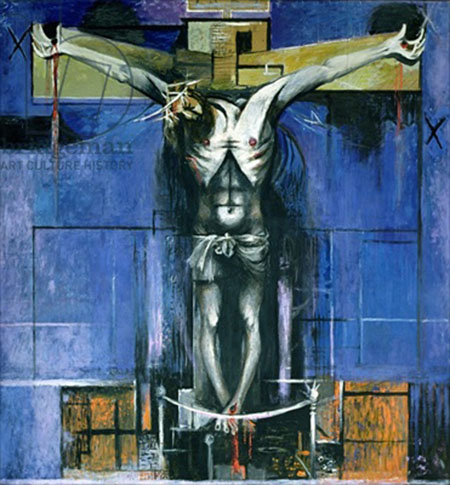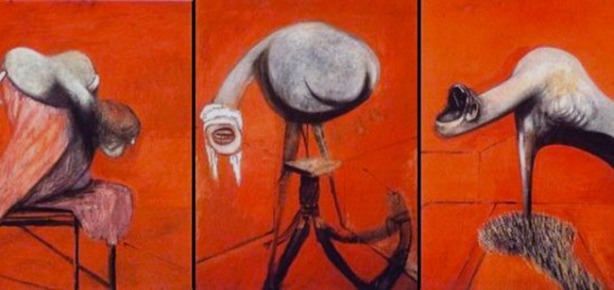In the 2012 Grade 12 Visual Arts final exam the following question was asked in the section of Art and the Spiritual Realm – Issues in Art Around Belief Systems and the Sacred.
During and after the devastation of the Second World War, two British Painters Graham Sutherland and Francis Bacon, both created religious images that were tortured and brutal.
Discuss the two works (Sutherland 1A and Bacon 1B) by referring to the following:
- The use of distortion in the images
- The use of colour
- Composition, space and use of structural/directional lines
- Possible interpretations/meanings of these works in a world devastated by war.

The Crucifixion, 1946 (oil on hardboard) by Sutherland, Graham; Saint Matthew’s Church, Northampton, Northamptonshire, UK
Memorandum to the question:
FIGURE 1A. Graham Sutherland, Crucifixion 1, 1946.
Painted just after the horrors of World War 2, Sutherland portrays Christ on the cross in a distorted angst-ridden manner. The work was based on Grünewald’s Crucifixion in the Isenheim Altarpiece. It is the most tragic of themes – through death we have salvation – the hope of redemption.
The image of the Crucifixion is placed firmly in the centre of the rectangular composition. In this work, Christ’s body is suspended in torment against a blue background. This figure becomes a powerful image of physical and spiritual suffering. A suggestion of a crown of thorns is visible around Christ’s head. These thorns, the curving barbed forms, served as symbols of human cruelty and suffering.
The use of distortion in terms of the outstretched arms nailed to the cross, with hands open and facing upwards, slumped head, ribs and sunken, emaciated torso, emphasises the suffering of Christ
In front of the crossed over feet of Christ, there is a single rope barrier separating the viewer from the image.
The use of colour is interesting. The strong orange rectangular shape at the base of the composition forms a dynamic contrast with the complimentary blue of the background. Touches of lilac are scumbled over the blue background in places. A more dominant lilac area is painted next to the right leg of Christ and helps to emphasise the verticality of the figure. The dark black shadows behind the white figure of Christ and parts of the cross, pushes the agonised figure forward. This, and the slight use of perspective seen at the top of the cross, gives the sense of limited space in the composition.
Strong structural/directional lines are evident on both the orange rectangle and blue background. These also tend to flatten the space. The figure is outlined boldly in black
FIGURE 1B: Francis Bacon, Three studies for figures at the base of a crucifixion, 1944.
Bacon began to paint images based on the Crucifixion in 1933.
Painted by Bacon in 1944, this is a triptych The work is based on the Greek Furies and his interpretations of the Crucifixion, and depicts three writhing anthropomorphic creatures set against a flat burnt orange background.
Three studies was done in oil paint and pastel on fibre board and completed within the space of two weeks. His intention was to paint a huge Crucifixion figure and place these figures at the foot of the cross. This was never done.
The Three studies triptych is generally considered Bacon’s first mature piece – he regarded the works he created before the triptych, as irrelevant, and throughout his life tried to suppress their appearance on the art market.
Use of distortion/colour
In this work he makes use of deliberately distorted, elongated, dislocated organic forms- half human, half animal. One feels that they could bite, probe, and suck, with their very long eel-like necks and open mouths – but strangely, they are sightless. Each panel shows a single taut sculptural form contrasted against a harsh red /orange background.
Perhaps it is this red /orange background that makes one think of entrails, of an anatomy or a vivisection. It makes us feel squeamish.
The flesh tones of the figures were achieved by overlaying grey and white brushstrokes, while the figures’ props were coloured using a variety of yellow, green, white, and purple tones.
It has been suggested that of the three figures, the one on the left most closely resembles a human form, and that it might represent a mourner at the cross.
Seated on a table-like structure, this limbless creature has an elongated neck, heavily rounded shoulders, and a thick mop of dark hair. Like its sister objects, the left-hand figure is portrayed with layers of white and grey paint.
The central figure’s mouth is positioned directly on its neck, rather than on a distinct face. It bares its teeth as if in a snarl, and is blindfolded by a drooping cloth bandage. This creature faces the viewer directly and is centralised by a series of converging lines radiating from the base of the pedestal.
Situated on an isolated patch of grass, the right-hand figure’s toothed mouth is stretched open as if screaming, or perhaps yawning. Its mouth is open to a degree impossible for a human skull.
The orange background of this panel is brighter than on the other two panels, and the figure’s neck opens up into a row of teeth, while a protruding ear juts out from behind its lower jaw.
Use of directional lines
Bacon made use of an interesting spatial dynamic of three lines radiating from the central figure. The other two panels suggest an interior space – a low-ceilinged, windowless and oddly proportioned space – other than that the space has been flattened due to the strong red background that jumps forward towards the viewer. One cannot ignore the demonic creatures thus creating a mood that is violent and foreboding.
These frightened, blind, raging figures are visceral in their impact, jolting one into sensations of fright, horror, isolation and angst. We react to them as self-conscious creatures, their postures and expressions revealing feelings of petrified isolation, searing horror, pain and blind confusion.
When the painting was first exhibited in 1945, it caused a sensation, and helped to establish him as one of the foremost post-war painters.


